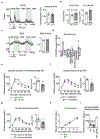Gut intraepithelial T cells calibrate metabolism and accelerate cardiovascular disease
- PMID: 30700910
- PMCID: PMC6367023
- DOI: 10.1038/s41586-018-0849-9
Gut intraepithelial T cells calibrate metabolism and accelerate cardiovascular disease
Abstract
The biochemical response to food intake must be precisely regulated. Because ingested sugars and fats can feed into many anabolic and catabolic pathways1, how our bodies handle nutrients depends on strategically positioned metabolic sensors that link the intrinsic nutritional value of a meal with intermediary metabolism. Here we describe a subset of immune cells-integrin β7+ natural gut intraepithelial T lymphocytes (natural IELs)-that is dispersed throughout the enterocyte layer of the small intestine and that modulates systemic metabolism. Integrin β7- mice that lack natural IELs are metabolically hyperactive and, when fed a high-fat and high-sugar diet, are resistant to obesity, hypercholesterolaemia, hypertension, diabetes and atherosclerosis. Furthermore, we show that protection from cardiovascular disease in the absence of natural IELs depends on the enteroendocrine-derived incretin GLP-12, which is normally controlled by IELs through expression of the GLP-1 receptor. In this metabolic control system, IELs modulate enteroendocrine activity by acting as gatekeepers that limit the bioavailability of GLP-1. Although the function of IELs may prove advantageous when food is scarce, present-day overabundance of diets high in fat and sugar renders this metabolic checkpoint detrimental to health.
Conflict of interest statement
Competing Financial Interests
None.
Figures














Comment in
-
Gut immune cells have a role in food metabolism.Nature. 2019 Feb;566(7742):49-50. doi: 10.1038/d41586-019-00235-5. Nature. 2019. PMID: 30710125 No abstract available.
-
Gut IELs slow metabolism.Nat Rev Immunol. 2019 Mar;19(3):138-139. doi: 10.1038/s41577-019-0133-8. Nat Rev Immunol. 2019. PMID: 30723308 No abstract available.
-
T cells in gut linked to metabolism.Nat Rev Endocrinol. 2019 Apr;15(4):192. doi: 10.1038/s41574-019-0177-7. Nat Rev Endocrinol. 2019. PMID: 30770897 No abstract available.
-
T cells in the gut promote CVD and slow metabolism.Nat Rev Cardiol. 2019 Apr;16(4):201. doi: 10.1038/s41569-019-0173-6. Nat Rev Cardiol. 2019. PMID: 30783254 No abstract available.
-
Gut T Cells Feast on GLP-1 to Modulate Cardiometabolic Disease.Cell Metab. 2019 Apr 2;29(4):787-789. doi: 10.1016/j.cmet.2019.03.002. Cell Metab. 2019. PMID: 30943389
-
Immunometabolism Sentinels: Gut Surface T-Cells Regulate GLP-1 Availability.Endocrinology. 2019 May 1;160(5):1177-1178. doi: 10.1210/en.2019-00215. Endocrinology. 2019. PMID: 30958533 Free PMC article. No abstract available.
References
-
- Begg DP & Woods SC The endocrinology of food intake. Nat Rev Endocrinol 9, 584–597 (2013). - PubMed
-
- Drucker DJ The Cardiovascular Biology of Glucagon-like Peptide-1. Cell Metab 24, 15–30 (2016). - PubMed
-
- Cerf-Bensussan N, Begue B, Gagnon J & Meo T The human intraepithelial lymphocyte marker HML-1 is an integrin consisting of a beta 7 subunit associated with a distinctive alpha chain. Eur J Immunol 22, 885 (1992). - PubMed
-
- Holzmann B, McIntyre BW & Weissman IL Identification of a murine Peyer’s patch--specific lymphocyte homing receptor as an integrin molecule with an alpha chain homologous to human VLA-4 alpha. Cell 56, 37–46 (1989). - PubMed
Publication types
MeSH terms
Substances
Grants and funding
LinkOut - more resources
Full Text Sources
Other Literature Sources
Molecular Biology Databases

